Fact:
On April 3, 2017, the day Vladimir Putin was due to visit the city, a suicide bombing was carried out in the St. Petersburg metro, killing 15 people and injuring 64. An al-Qaeda affiliate, Imam Shamil Battalion, claimed responsibility.

This nineteenth and final monthly report will analyse the most important events and trends in Jihadi-terrorist social media reporting from the Sahel in the month of June 2024. Although the number of reported incidents by al-Qaeda and Islamic State related groups operating in the area dropped slightly, it remains significantly high. One hundred and twenty three statements were published, mostly about attacks, but the propaganda output regarding Da’wah (proselitization)—and other campaigns to either coerce or entice public support—by both al-Qaeda and the Islamic State is increasing. This is indicative of the trend that Jihadi terrorist groups in the Sahel are more and more prone to capitalizing on local population support throughout the entire region, not only by preaching but also through the application of Islamic penal law and the frequent statements condemning massacres committed by the putchsist regimes in the region.
In terms of the geographical spread of reported incidents, it is the first time in the 19-month reporting period that the highest number of statements were published in Burkina Faso. Nigeria comes in second and Mali third. For the fifth consecutive month in a row, the number of incidents claimed by JNIM is higher than those claimed by ISWAP or ISGS. June 2024 was the second time during the 19 months of reporting that that the number of claims published by JNIM was higher than the number of claims published by both Islamic State Provinces (ISWAP and ISGS) combined. This clearly points to a sharp increase of reported activities by the al-Qaeda affiliate in the region. As in previous months, again, the number of incidents reported by ISGS remains remarkably low, with only 15 registered claims.
As for attacks on the civilian population by the Sahelian military regimes, JNIM reported three incidents in Burkina Faso and two in Mali. In both the attacks in Mali JNIM explicitly accuses the former Wagner Group of involvement in the brutal killing of at least 20 civilians. In addition, eleven attacks against the Russian mercenaires and government military were claimed in Mali. JNIM claimed six, killing an undisclosed number of Malian soldiers and Russians, whereas ISGS claimed five attacks, killing and wounding at least 75. Furthermore JNIM mentioned two attacks directly aimed at the Russian mercenaries. Finally, infighting between the various Jihadi-terrorist groups in the region seems to be flaring up again. JNIM attacked ISGS once in Mali, killing one leader and two fighters. ISGS attacked JNIM three times in Burkina Faso, killing a few dozen JNIM-fighters.
It is important to highlight that every single month of 2024 (with the exception of March) counted more than 120 claimed incidents. This continuing rise of the number of operations is extremely concerning and indicative of a rapidly deteriorating security situation. Burkina Faso is on the brink of collapse; Mali is heading there quickly. Furthermore there are clear indications that Jihadi-terrorist groups in the Sahel are continuing efforts to expand into countries currently less affected by terrorist violence, something that has been confirmed as recently as October 22, 2024 when az-Zallaqa Media published a video with one of JNIM’s leaders, Mohamed Koufa, answering an interview request from French journalist Wassim Nasr. Furthermore it has become clear, as reported by Reuters, also in late October 2024, that Ghana has become a pivotal link in JNIM’s organisation for finding refuge and supplies.
Another element pointing to increasing activity by JNIM throughout the region was the massacre committed by JNIM in the Burkinabe town of Barsalogho on August 24, 2024. According to Human Rights Watch, at least 133 civilians were brutally killed, but the number of victims likely exceeds 300, as reported earlier by The Telegraph and other news outlets. Mali also suffered deadly violence unleashed by the al-Qaeda affiliate. On September 17, 2024 two attacks in the capital of Bamako claimed at least 80 victims. But Bamako already faced a bigger challenge. On July 25, 2024 Touareg rebels of the CSP-DPA (Cadre stratégique pour la défense du peuple de l'Azawad) attacked a convoy of the Malian army and the Wagner Group near Tinzaouten, close to the Algerian border. Completely overwhelmed, the convoy returned to base, only to be subsequently attacked by JNIM. Footage released by CSP and JNIM shows multiple corpses of killed Russians, Malian soldiers, and destroyed vehicles. The exact number of casualties was not disclosed by the Russian mercenaries or the Malian army, but CSP sources claimed 84 Russians and 47 Malian soldiers were killed. JNIM claimed to have additiionally killed 50 Russians and 10 Malian servicemen. The battle ended two days later, on July 27, 2024 with a major defeat for the Malian army and the Russian mercenaries.
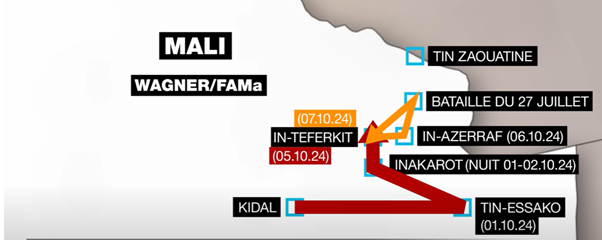
In addition to the rising levels of Jihadi-terrorist and government orchestrated violence, Da’wa (proselytization) campaigns and the application of Islamic Penal Law on local communities by both al-Qaeda and the Islamic State continues to increase. Therefore, all Jihadi terrorist factions throughout the Sahel continue their slow but steady state-building project. It is only a matter of time before one or more of the dominos will fall, likely leading to the complete or partial collapse of countries such as Mali and Burkina Faso. Obviously this will also lead to an increase in the number of internally displaced persons as well as the number of refugees fleeing towards Europe via the Spanish Canary Islands.
In order to gain additional analytic insights, ChatGPT was tasked with computing a rough estimate of potential future trends in the region. The were the results:
“using a linear regression model, the projected monthly attacks for the next 12 months range from approximately 139 in July 2024 to 203 in June 2025. Summing these monthly predictions gives an estimated total of about 2,049 attacks over the next year if the current trend continues.”
It is important to highlight that this grim prediction is based only on data cleaned from reports published by the terrorist groups themselves about their attacks. As has been pointed out repeatedly in previous reports, all three terrorist groups in the region—JNIM, ISWAP and ISGS—continuously under-report their attacks. The actual number of terrorist incidents in the region is likely to be significantly higher.

Source: https://x.com/J_LuengoCabrera/status/1803500187794473346
Table 1: Claimed Attacks (December 2022 – June 2024)
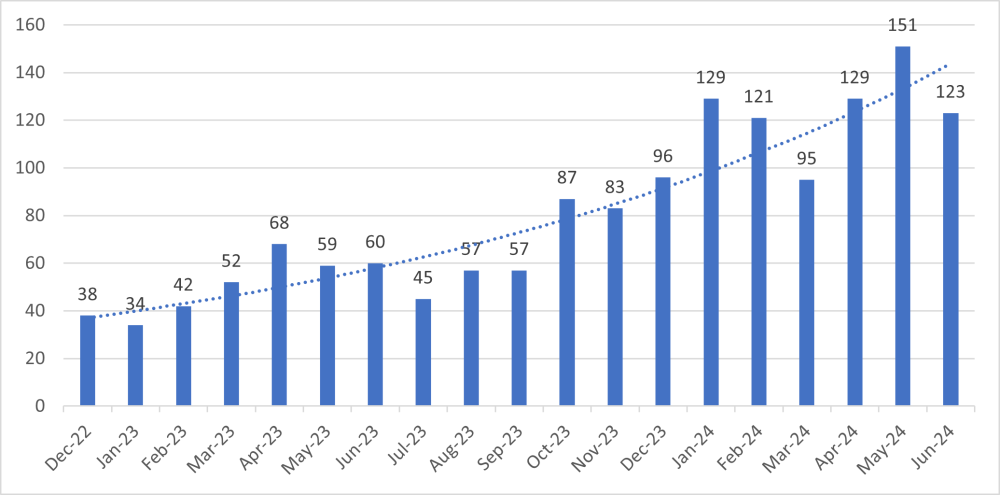
Table 2: Claimed Attacks per Group (December 2022 – June 2024)
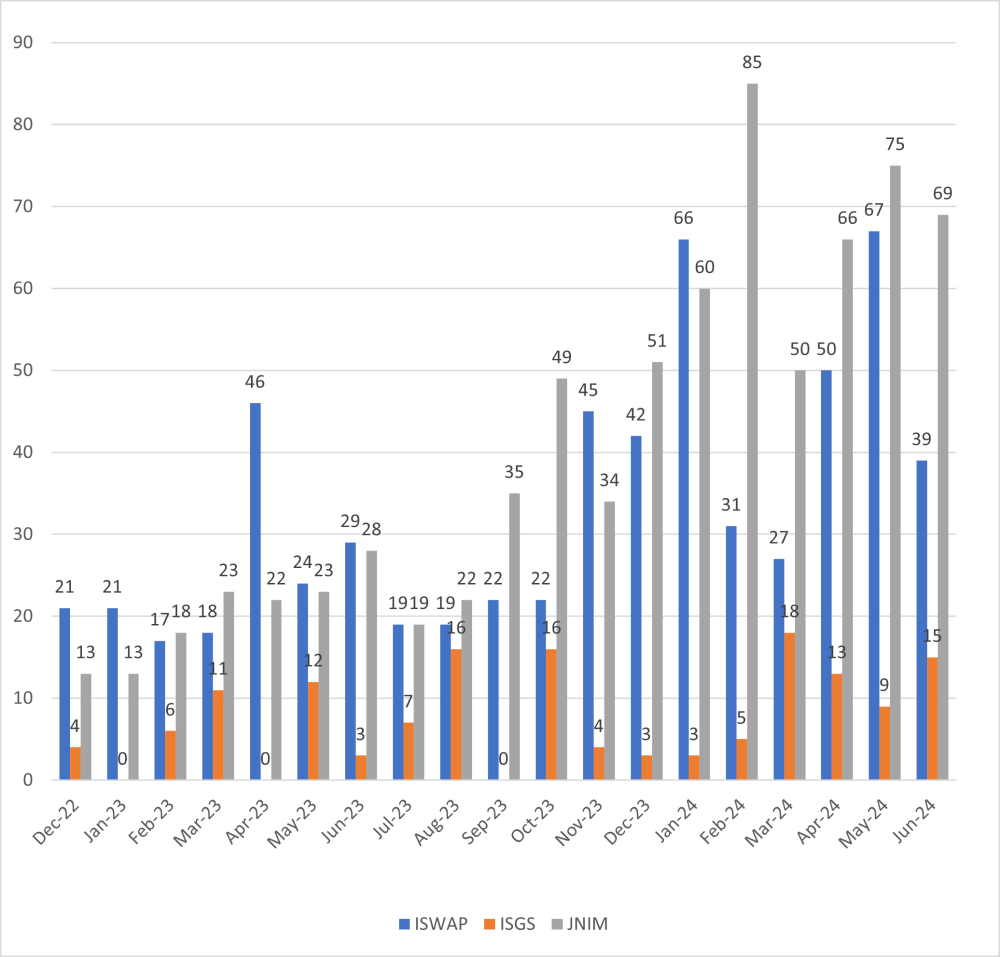
Table 3: Claimed Attacks per Country (December 2022 – June 2024)
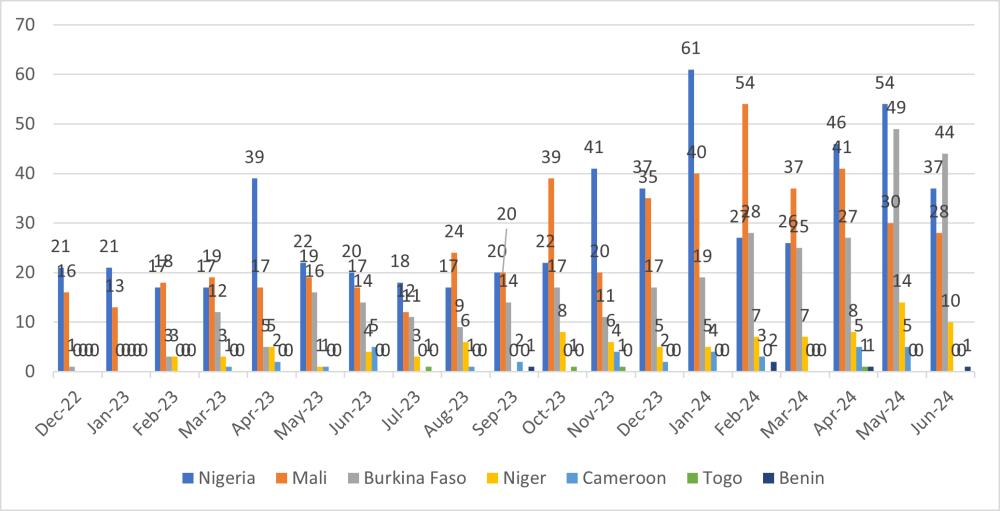
The month of June witnessed a total number of 44 reported operations in Burkina Faso alone – this is in stark contrast to December 2022 when only one claim was published. Consequently, Burkina Faso currently has the hightest number of claimed terrorist incidents in the region. Only five of the 44 claimed attacks were reported by ISGS; the rest were reported by JNIM, which continues to develop its operations in the country. The overall majority of claims were published by az-Zallaqa Media on account of JNIM. ISGS only published five statements, three of which concerned attacks on JNIM. This likely indicates that ISGS is increasingly worried about the success of JNIM’s state building activities in Mali and Burkina Faso, but is in no position to counter it.

Source: https://x.com/julesdhl/status/1802977198799810847
In June, the situation in Nigeria did not significantly change, with an aproximate number of 40 attacks by ISWAP. On average, during the period of reporting, Nigeria suffered about 29 incidents per month, with only two remarkable highs (61 in January 2024 and 54 in May 2024). Most attacks in the month of June 2024, as before, were aimed at the army and loyalist militia, and were of relatively low impact when compared to the mayhem caused by large scale attacks in Burkina Faso, Mali, and Niger.
Mali featured in Jihadi-terrorist propaganda output on 28 occasions during the month of June. 22 reports were published by az-Zallaqa Media on JNIM’s account. Seven of these attacks were aimed at the Malian army and Russian mercenaries. Two statements were published accusing the Malian army and the Wagner Group of commiting atrocities among the local population, in which around 20 people were reportedly killed. Furthermore there were two picture reports of the ‘Id al-Adha celebrations on the frontlines and one video of a training in a JNIM training camp. On one occasion, az-Zallaqa Media mentioned an attack on ISGS during which one leader and two militants were killed.
ISGS published a picture report from ‘Id celebrations and five statements about attacks on the Malian army and the Wagner Group. The Islamic State claimed to have killed at least 76 Malian soldiers and Russian mercenaries.
The ever increasing number of attacks on the army and the Wagner Group and the September 17, 2024 attacks in Mali’s capital Bamako indicate that the security situation is slowly collapsing on a national scale. Therefore, the complete collapse of government control in the country is increasingly likely.

Source: https://x.com/julesdhl/status/1803373932986192077
Niger is the only country in the list that suffered attacks from all groups involved. Four incidents were claimed by JNIM, four by ISGS and two by ISWAP. The most impactful attacks were on June 8, 2024 by ISGS, killing at least 11 militia-members and on June 25, 2024 by JNIM leading to more than 40 Nigerien soldiers killed in Tillaberi province. Most remarkable, however, was the application of Islamic penal law in the country by ISGS. On June 20 and 30, respectively, four men accused of brigandery were executed and the hands of three thieves were amputated. As before in Syria and Iraq, the Islamic State is implementing Islamic law to enforce it’s grip over the local population, a phenonemon we will likely see re-occuring in an increasing number of communities in the not so distant future
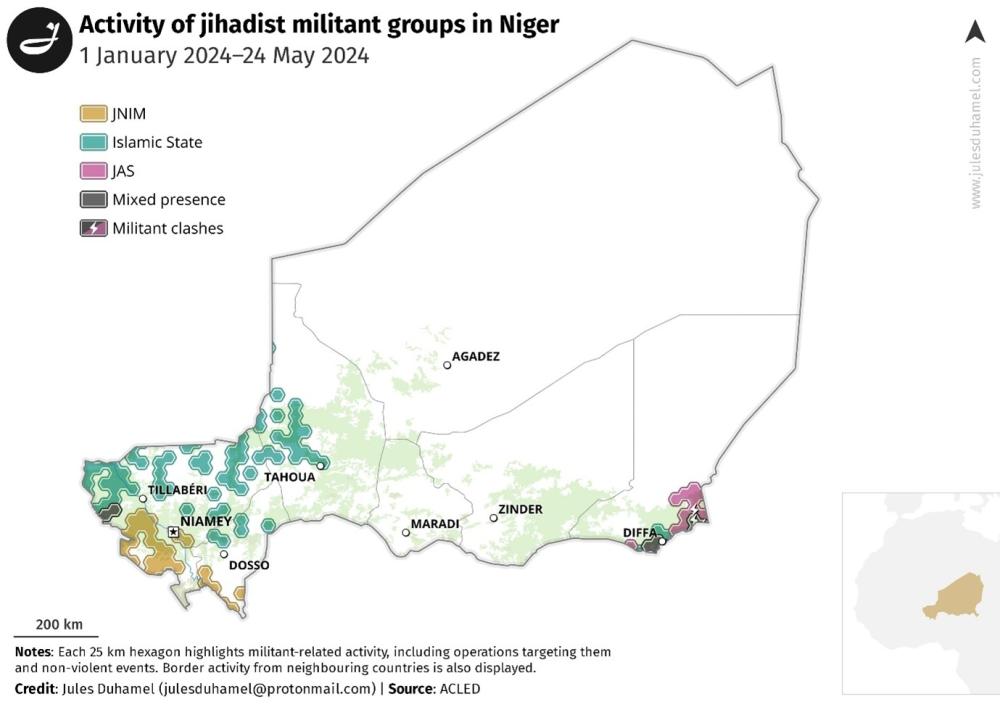
Source: https://x.com/julesdhl/status/1803695191804493898
One single operation was claimed by JNIM in Benin, no casualties were reported.
Table 4: Total number of attacks
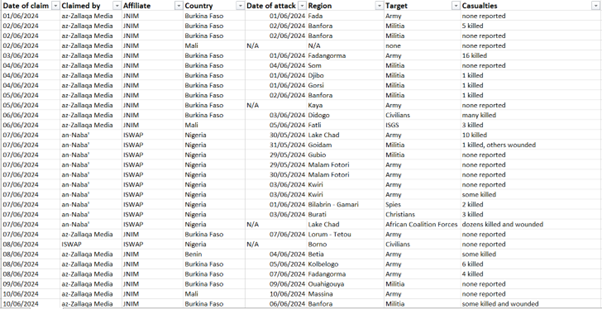
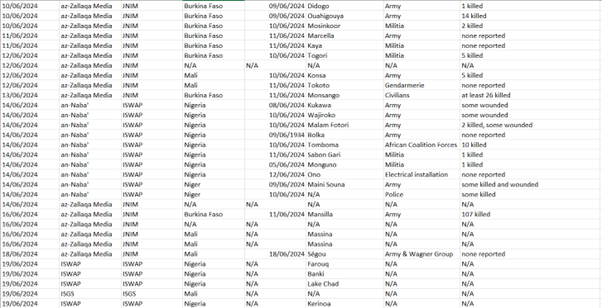
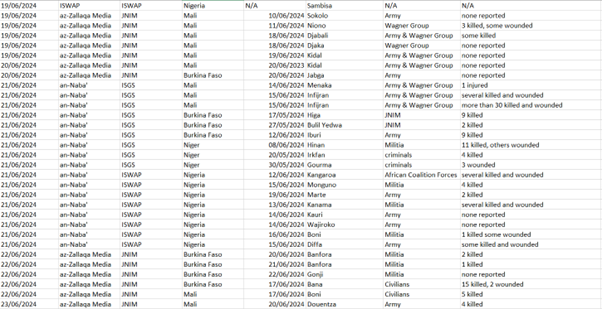

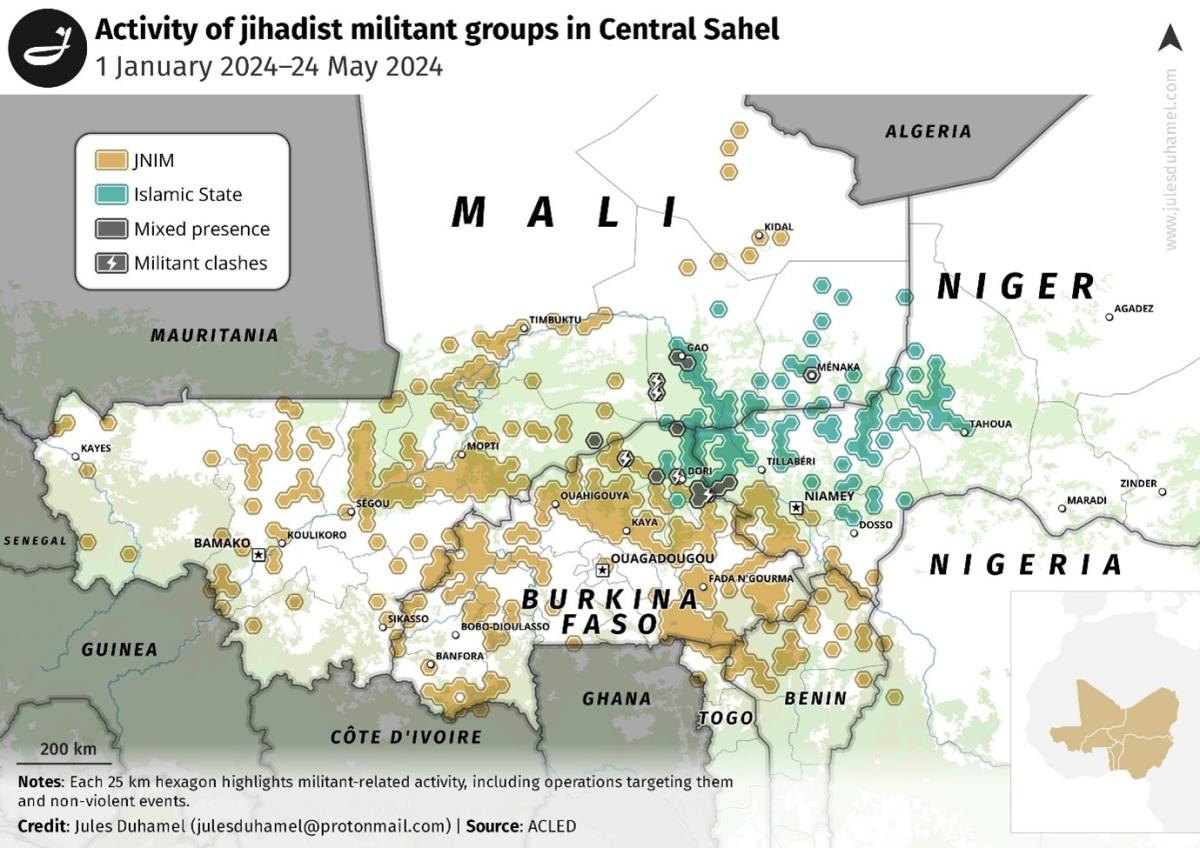
Source: https://x.com/julesdhl/status/1804096044541579347
A total of 69 statements, videos, and picture reports were published by az-Zallaqa Media. The overall majority were from Burkina Faso (39) followed by Mali (22), Niger (4) and Benin (1). A total of five reports were published by JNIM accusing the Burkinabe and Malian army of committing atrocities among the local population.
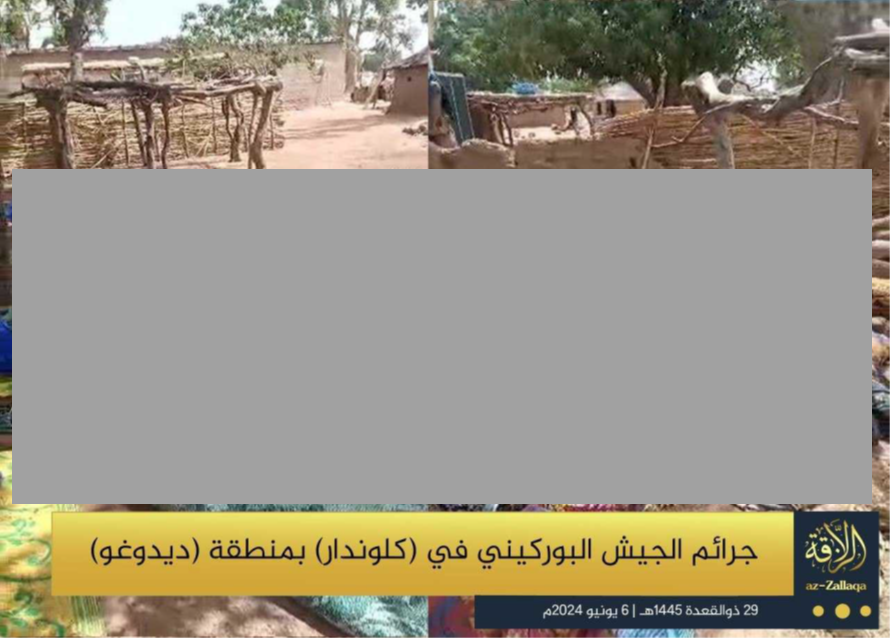
NOTE: Redaction due to the violent nature of the imagery
Eight statements were published referring to attacks on the Malian army and the Wagner Group. An undisclosed number of soldiers and mercenaries were killed in these clashes. By far the most impactful attack was on June 25, 2024 in Tassia, Niger, targeting the army. A total of more than 40 soldiers were reportedly killed or wounded.
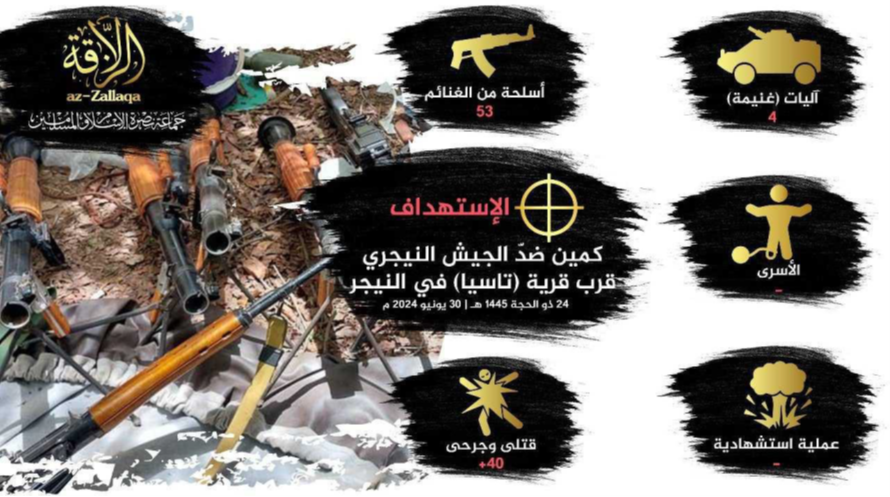
Table 5: Claims by JNIM
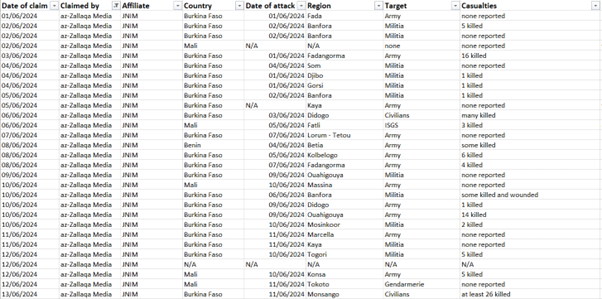
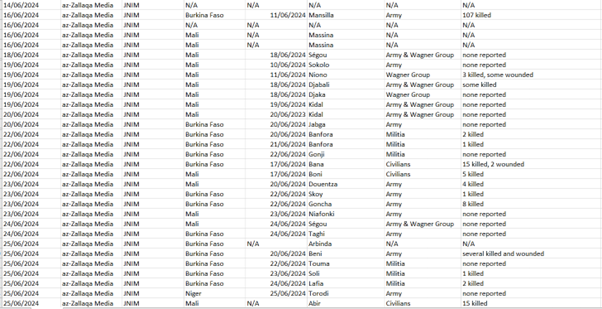

A total of 39 statements and picture sets were published by an-Naba’ on behalf of ISWAP or by ISWAP itself, the obligatory photosets of ‘Id al-Adha celebrations included. ISWAP attacks are generally low-level events, killing or wounding a handful of soldiers or militia members. But in one case, during an attack in the Lake Chad area, dozens of African Coalition Forces were killed according to an-Naba’.
Table 6: Claims by ISWAP
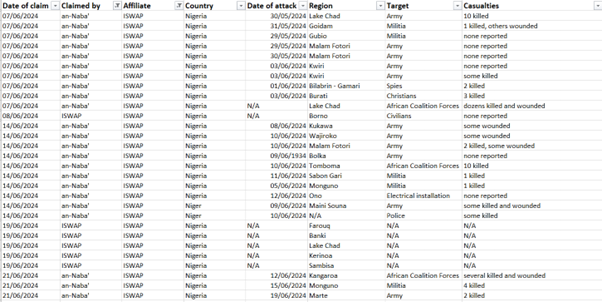

ISGS continues to systematically underreport its attacks. During June only 15 claims and picture sets were published, a picture set of ‘Id al-Adha celebrations is included in this statitic. Furthermore on two occasions ISGS implemented Islamic penal law in Niger. Four men accused of brigandery were killed, three more men accused of theft had their right hand amputated. Five clashes with the Malian army and the Wagner Group were reported, leading to over 75 casualties. On at least two occasions JNIM was targeted by ISGS fighters, reportedly killing 11 al-Qaeda terrorists.
Table 7: Claims by ISGS

During nineteen consecutive months between December 2022 and the end of June 2024, this report systematically monitored and analysed all Jihadi media output by the Islamic State and al-Qaeda in the region. This project concentrated solely on the propaganda output of JNIM, ISGS, and ISWAP and did not attempt to independently cross-check reported attacks with other independent sources. The aim was to analyse the developing terrorist strategy and tactics in the region. However, interestingly, claims made by al-Qaeda were regularly independently confirmed by non-state actors like the Red Cross and Human Rights Watch. (See previous reports)
During the reporting period, the project collected a total of 1526 statements, videos, and picture reports, with an impact on seven different countries throughout the region. Nigeria bore the brunt of attacks with an overall of 563 recorded claims, followed by Mali (499), Burkina Faso (322), Niger (95), Cameroon (35), Benin (5) and Togo (4). As some claims were never physically located by the groups reporting, there is an obvious – yet rather small – discrepancy. Seven hundred and fifty-five claims were published by az-Zallaqa Media on behalf of JNIM, 625 by ISWAP and a meagre 145 by ISGS.
After the ‘Id al-Adha celebrations, marking the end of AH 1445 (July 19, 2023 – July 6, 2024), az-Zallaqa Media published an overview of its operations in the previous year. Keeping in mind that the propaganda outlet is slightly underestimating the impact of their operations, the number they present is around 2500 killed victims in a one-year period. The total number of casualties inflicted by the Islamic State is harder to estimate but also very significant. Therefore, if the ACLED data for 2024 is taken into account, it is likely that the number of attacks and victims of Jihadi-terrorist related violence in the region will reach an unprecedented high.
It is very likely that this trend will continue because of the growing influence of JNIM, ISWAP and ISGS. The security situation in the Sahel region will deteriorate further. If current trends are not significantly and sustainably reversed, it is very possible that by June 2025 the number of terrorist incidents in the region could exceed 250 incidents per month. Jihadi-terrorist violence has only increased since the military coups in Mali, Burkina Faso, and Niger. It is concerning that leading al-Qaeda ideologists are openly arguing in interviews with international media that they are hopeful that they will be able to expand into the littoral countries of the Gulf of Guinea. Given the current trajectory, this is no longer an unlikely scenario. Currently, it is unclear how much longer countries such as Burkina Faso or Mali will be able to sustain increasing levels of terrorist violence before the domestic security structures collapse entirely. Given the central geographical position of these countries in the Sahel region, a takeover of either one by al-Qaida or ISIS forces would be a game changer for regional security and would very likely have consequences for the overall global terrorist threat.
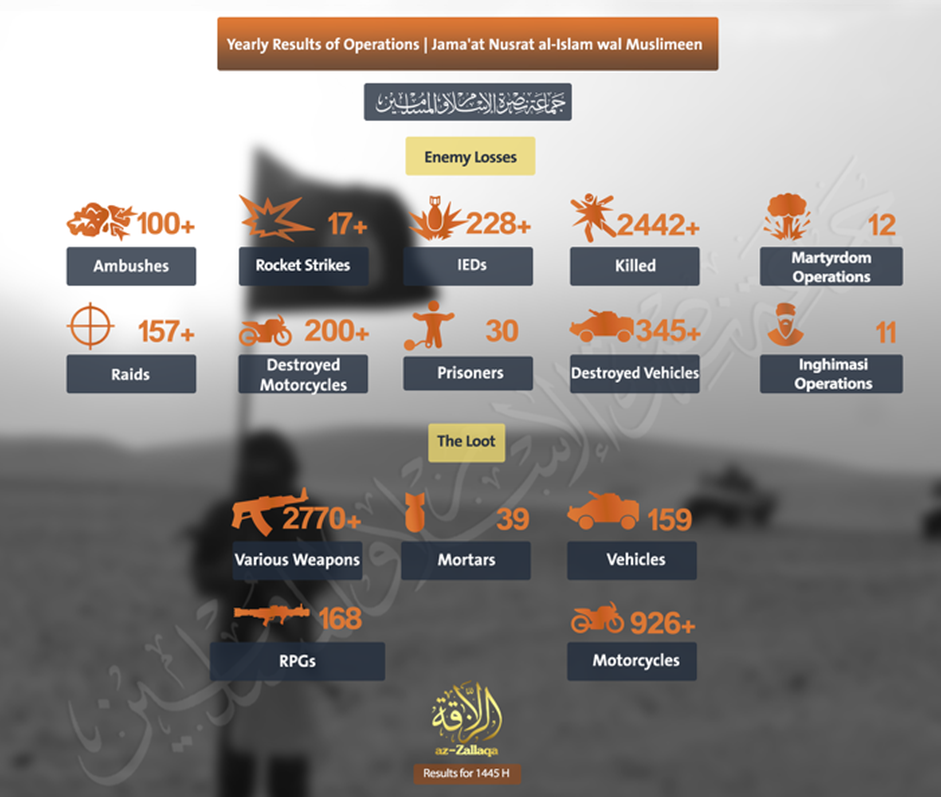
Extremists: Their Words. Their Actions.
Fact:
On April 3, 2017, the day Vladimir Putin was due to visit the city, a suicide bombing was carried out in the St. Petersburg metro, killing 15 people and injuring 64. An al-Qaeda affiliate, Imam Shamil Battalion, claimed responsibility.
Get the latest news on extremism and counter-extremism delivered to your inbox.